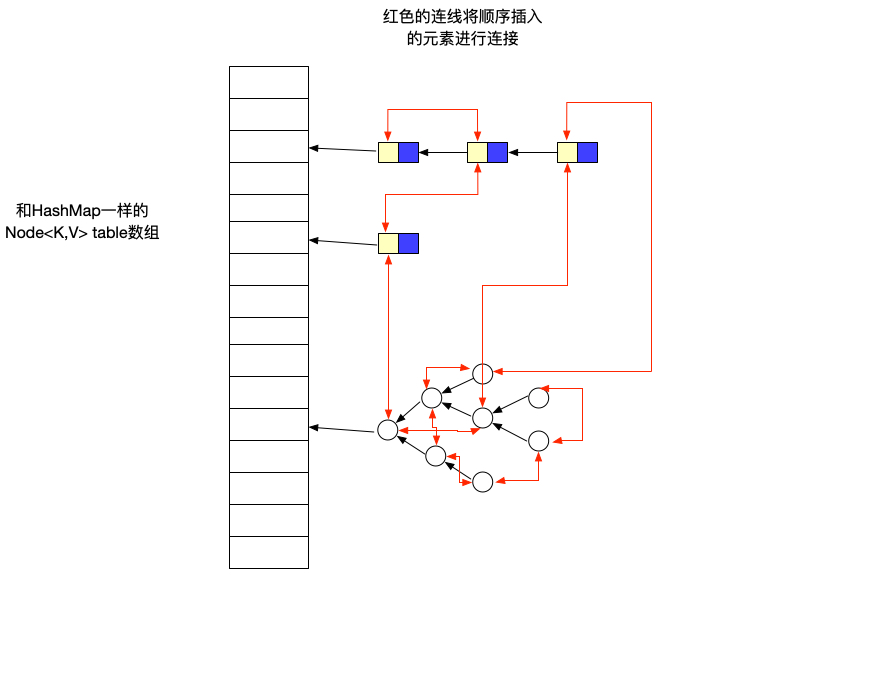LinkedHashMap继承了HashMap类,实现了Map接口。
他与HashMap的主要区别就是使用链表存储了每个节点的顺序。这样就能保证有序。
来看一下他的节点情况:
1 2 3 4 5 6 static class Entry <K ,V > extends HashMap .Node <K ,V > Entry<K,V> before, after; Entry(int hash, K key, V value, Node<K,V> next) { super (hash, key, value, next); } }
从这里可以看出他使用了两个变量,before,after存储这个节点的前后顺序。
构造方法 1 2 3 4 5 6 7 8 9 10 11 12 13 14 15 16 17 18 19 20 21 22 23 24 25 26 27 public LinkedHashMap () super (); accessOrder = false ; } public LinkedHashMap (int initialCapacity) super (initialCapacity); accessOrder = false ; } public LinkedHashMap (int initialCapacity, float loadFactor) super (initialCapacity, loadFactor); accessOrder = false ; } public LinkedHashMap (int initialCapacity, float loadFactor, boolean accessOrder) super (initialCapacity, loadFactor); this .accessOrder = accessOrder; } public LinkedHashMap (Map<? extends K, ? extends V> m) super (); accessOrder = false ; putMapEntries(m, false ); }
LinkedHashMap一共有5个构造方法,仔细看一下主要是三个参数:initialCapacity,loadFactor,accessOrder这三个变量。并且他们都调用了父类也就是HashMap的构造方法。
initialCapacity,loadFactor这两个在看HashMap的时候就了解到这是初始容量值与扩容阈值,就不仔细说了,如果想仔细了解这两个字段可以看这一篇HashMap源码学习 。
那就主要看一下accessOrder。
1 2 3 4 5 6 7 final boolean accessOrder;
这个字段也给出了注释,如果为true则表示基于访问顺序,如果为false则基于插入顺序。所以我们想要的按照访问顺序取就要设置为false。如果为true则按照访问顺序排序,将访问过的元素放到链表后面。我们用代码看一下实际效果。
1 2 3 4 5 6 7 8 9 10 11 12 13 14 15 16 17 18 19 20 21 22 public static void main (String[] args) LinkedHashMap<String, Integer> first = new LinkedHashMap<String, Integer>(16 , 0.75f , false ); first.put("1" , 1 ); first.put("2" , 2 ); first.put("3" , 3 ); first.put("4" , 4 ); first.get("1" ); first.get("3" ); System.out.println(first); LinkedHashMap<String, Integer> second = new LinkedHashMap<String, Integer>(16 , 0.75f , true ); second.put("1" , 1 ); second.put("2" , 2 ); second.put("3" , 3 ); second.put("4" , 4 ); second.get("1" ); second.get("3" ); System.out.println(second); } {1 =1 , 2 =2 , 3 =3 , 4 =4 } {2 =2 , 4 =4 , 1 =1 , 3 =3 }
初始化了两个容量,负载系数都一样的LinkedHashMap,第一个设置accessOrder属性为false,第二个设置为true。
然后都执行了相同的代码。先放入元素,然后中间对其中几个元素进行读取。最后在输出查看。
我们可以看到第一个也就是accessOrder属性设置成false的虽然中间获取了元素,但是他的打印顺序还是按照放入顺序的。而第二个中间对两个元素进行了获取,所以他将这两个元素放在了后面,打印顺序是我们放入的顺序再加上访问顺序后最终得到的顺序。
添加元素 调用了父类HashMap的方法。
1 2 3 4 5 6 7 8 9 10 11 12 13 14 15 16 17 18 19 20 21 22 23 24 25 26 27 28 29 30 31 32 33 34 35 36 37 38 39 40 41 42 43 44 45 46 public V put (K key, V value) return putVal(hash(key), key, value, false , true ); } final V putVal (int hash, K key, V value, boolean onlyIfAbsent, boolean evict) Node<K,V>[] tab; Node<K,V> p; int n, i; if ((tab = table) == null || (n = tab.length) == 0 ) n = (tab = resize()).length; if ((p = tab[i = (n - 1 ) & hash]) == null ) tab[i] = newNode(hash, key, value, null ); else { Node<K,V> e; K k; if (p.hash == hash && ((k = p.key) == key || (key != null && key.equals(k)))) e = p; else if (p instanceof TreeNode) e = ((TreeNode<K,V>)p).putTreeVal(this , tab, hash, key, value); else { for (int binCount = 0 ; ; ++binCount) { if ((e = p.next) == null ) { p.next = newNode(hash, key, value, null ); if (binCount >= TREEIFY_THRESHOLD - 1 ) treeifyBin(tab, hash); break ; } if (e.hash == hash && ((k = e.key) == key || (key != null && key.equals(k)))) break ; p = e; } } if (e != null ) { V oldValue = e.value; if (!onlyIfAbsent || oldValue == null ) e.value = value; afterNodeAccess(e); return oldValue; } } ++modCount; if (++size > threshold) resize(); afterNodeInsertion(evict); return null ; }
先来看afterNodeInsertion方法
1 2 3 4 5 6 7 8 9 10 11 void afterNodeInsertion (boolean evict) LinkedHashMap.Entry<K,V> first; if (evict && (first = head) != null && removeEldestEntry(first)) { K key = first.key; removeNode(hash(key), key, null , false , true ); } } protected boolean removeEldestEntry (Map.Entry<K,V> eldest) return false ; }
这个方法我就没看明白了,他判断条件三个同时成立才会走,然后第三个条件直接返回了false。这不就永远不执行了,还是说实际调用的是其他实现方法?欢迎大家指教。
获取元素 1 2 3 4 5 6 7 8 public V get (Object key) Node<K,V> e; if ((e = getNode(hash(key), key)) == null ) return null ; if (accessOrder) afterNodeAccess(e); return e.value; }
现在来看一下之前没说的方法afterNodeAccess
1 2 3 4 5 6 7 8 9 10 11 12 13 14 15 16 17 18 19 20 21 22 23 24 void afterNodeAccess (Node<K,V> e) LinkedHashMap.Entry<K,V> last; if (accessOrder && (last = tail) != e) { LinkedHashMap.Entry<K,V> p = (LinkedHashMap.Entry<K,V>)e, b = p.before, a = p.after; p.after = null ; if (b == null ) head = a; else b.after = a; if (a != null ) a.before = b; else last = b; if (last == null ) head = p; else { p.before = last; last.after = p; } tail = p; ++modCount; } }
这里有accessOrder属性的判断,当其为true时才会执行下面的代码,所以只有在构造函数中将这个属性设置成true时这个方法才会走。
这个方法的作用就是将这个节点放到整个链表的最后。如果这个节点有下一个节点,则将上一个节点连接到下一个节点。然后将这个节点设置成最后一个节点。像我们刚才执行的演示代码:顺序放置了1,2,3,4。然后中间获取1。这是就走了这个方法,将1放置到了链表最后,变成了2,3,4,1。
参考文档 https://stackoverflow.com/questions/38974417/what-is-purpose-of-accessorder-field-in-linkedhashmap
